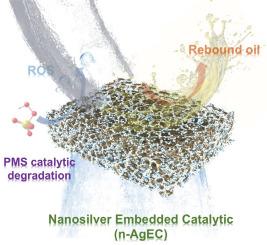Engineering self-rebound catalytic membranes for efficient high-viscosity oily wastewater purification and emerging contaminants removal
IF 12.4
1区 环境科学与生态学
Q1 ENGINEERING, ENVIRONMENTAL
引用次数: 0
Abstract
Separation membranes with high antifouling and self-cleaning capabilities are vital for long-term operation during practical high-viscosity fluid purification. Herein, we report an oil-rebound catalytic self-cleaning membrane constructed via a synergistic in situ reduction–coordination synthesis strategy. A hydrogen-bonded hydrogel of tea polyphenol/polyvinylpyrrolidone reduces and coordinates silver ions into an ultrathin hydrated Ag nanocoating at the membrane interface, providing a facile and robust route for directional nanoparticle loading. The membrane exhibited ultrahigh permeance for isooctane-in-water emulsion (>8800 L·m-2·h-1·bar-1) and remarkable antifouling stability (>99.9% rejection over multiple cycles, apart from ethanol and pH = 1 acid). When processing challenging emulsified high-viscosity oily wastewater, the engineered superwetting interface prevents oil adhesion due to a unique oil-rebound antifouling mechanism, maintaining consistently high permeance (>1000 L·m-2·h-1·bar-1 over 1 h). Notably, even under severe fouling conditions, the membrane maintains excellent regenerability, achieving 99.8% permeance recovery through efficient peroxymonosulfate (PMS)-activated catalytic cleaning towards various contaminants. This work demonstrates a facile biomimetic design strategy for advanced membranes in challenging separation scenarios.

工程自回弹催化膜用于高粘度含油废水的高效净化和新兴污染物的去除
在实际的高粘度流体净化过程中,具有高防污和自清洁能力的分离膜对于长期运行至关重要。在此,我们报道了一种通过协同原位还原-配位合成策略构建的油回弹催化自清洁膜。茶多酚/聚乙烯吡咯烷酮的氢键水凝胶在膜界面处将银离子还原并配位成超薄水合银纳米涂层,为定向加载纳米粒子提供了一种简便而可靠的途径。该膜对异辛烷水乳状液具有超高的渗透率(>8800 L·m-2·h-1·bar-1)和优异的防污稳定性(除乙醇和pH = 1酸外,多次循环去除率>;99.9%)。当处理具有挑战性的乳化高粘度含油废水时,由于独特的油回弹防污机制,设计的超润湿界面可以防止油粘附,保持持续的高渗透率(在1小时内达到1000 L·m-2·h-1·bar-1)。值得注意的是,即使在严重的污染条件下,膜也保持了出色的可再生性,通过对各种污染物的高效过氧单硫酸盐(PMS)激活的催化清洁,膜的渗透率恢复率达到99.8%。这项工作证明了在具有挑战性的分离场景中先进膜的简单仿生设计策略。
本文章由计算机程序翻译,如有差异,请以英文原文为准。
求助全文
约1分钟内获得全文
求助全文
来源期刊

Water Research
环境科学-工程:环境
CiteScore
20.80
自引率
9.40%
发文量
1307
审稿时长
38 days
期刊介绍:
Water Research, along with its open access companion journal Water Research X, serves as a platform for publishing original research papers covering various aspects of the science and technology related to the anthropogenic water cycle, water quality, and its management worldwide. The audience targeted by the journal comprises biologists, chemical engineers, chemists, civil engineers, environmental engineers, limnologists, and microbiologists. The scope of the journal include:
•Treatment processes for water and wastewaters (municipal, agricultural, industrial, and on-site treatment), including resource recovery and residuals management;
•Urban hydrology including sewer systems, stormwater management, and green infrastructure;
•Drinking water treatment and distribution;
•Potable and non-potable water reuse;
•Sanitation, public health, and risk assessment;
•Anaerobic digestion, solid and hazardous waste management, including source characterization and the effects and control of leachates and gaseous emissions;
•Contaminants (chemical, microbial, anthropogenic particles such as nanoparticles or microplastics) and related water quality sensing, monitoring, fate, and assessment;
•Anthropogenic impacts on inland, tidal, coastal and urban waters, focusing on surface and ground waters, and point and non-point sources of pollution;
•Environmental restoration, linked to surface water, groundwater and groundwater remediation;
•Analysis of the interfaces between sediments and water, and between water and atmosphere, focusing specifically on anthropogenic impacts;
•Mathematical modelling, systems analysis, machine learning, and beneficial use of big data related to the anthropogenic water cycle;
•Socio-economic, policy, and regulations studies.
 求助内容:
求助内容: 应助结果提醒方式:
应助结果提醒方式:


